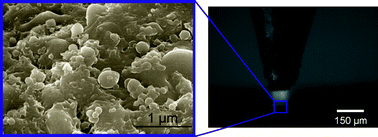Fabrication of nanocluster silicon surface with electric discharge and the application in desorption/ionization on silicon-mass spectrometry
Abstract
This study presents a new, simple, and low-cost technique to fabricate a nanocluster

* Corresponding authors
a
Division of Pharmaceutical Chemistry, University of Helsinki, P. O. Box 56, Finland
E-mail:
risto.kostiainen@helsinki.fi
Fax: +358 9 191 59 556
Tel: +358 9 191 59134
b Laboratory of Inorganic Chemistry, Department of Chemistry, University of Helsinki, P. O. Box 55, Finland
c Department of Micro and Nanosciences, Aalto University School of Science and Technology, P. O. Box 13500, Aalto, Finland
d Department of Materials Science and Engineering, Aalto University School of Science and Technology, P. O. Box 16200, Aalto, Finland
e Laboratory of Analytical Chemistry, Department of Chemistry, University of Helsinki, P. O. Box 55, Finland
This study presents a new, simple, and low-cost technique to fabricate a nanocluster

 Please wait while we load your content...
Something went wrong. Try again?
Please wait while we load your content...
Something went wrong. Try again?
N. M. Suni, M. Haapala, E. Färm, E. Härkönen, M. Ritala, L. Sainiemi, S. Franssila, T. Kotiaho and R. Kostiainen, Lab Chip, 2010, 10, 1689 DOI: 10.1039/B927181C
To request permission to reproduce material from this article, please go to the Copyright Clearance Center request page.
If you are an author contributing to an RSC publication, you do not need to request permission provided correct acknowledgement is given.
If you are the author of this article, you do not need to request permission to reproduce figures and diagrams provided correct acknowledgement is given. If you want to reproduce the whole article in a third-party publication (excluding your thesis/dissertation for which permission is not required) please go to the Copyright Clearance Center request page.
Read more about how to correctly acknowledge RSC content.
 Fetching data from CrossRef.
Fetching data from CrossRef.
This may take some time to load.
Loading related content
